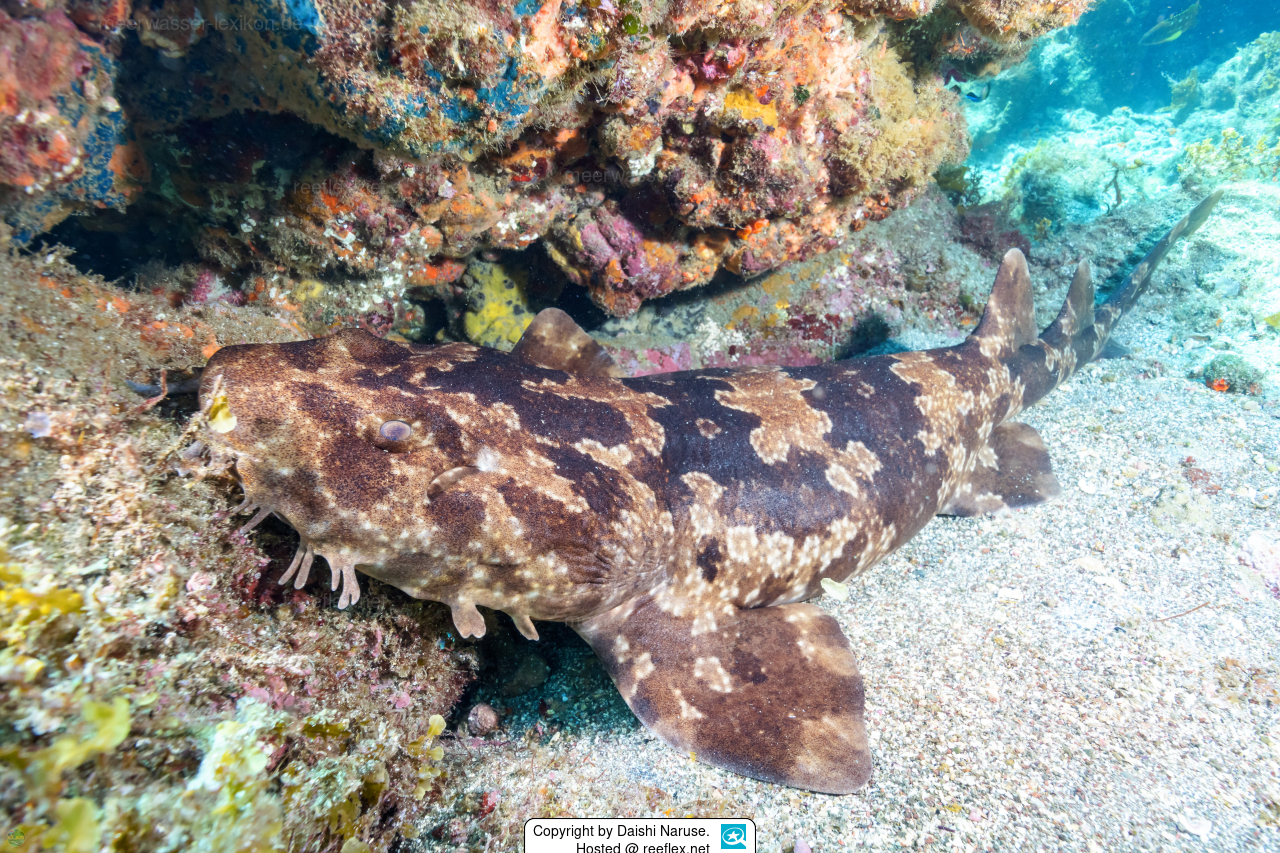Info
Orectolobus japonicus inhabits all types of sandy, muddy, rocky and coral areas on the coast to a depth of about 100 meters and has even been observed climbing over tidal ridges.
The Japanese carpet shark is mainly active at night and feeds on bottom invertebrates such as crabs, lobsters, squid and fish.
It is best to feed them enriched frozen and live foods such as crabs, shrimp, fish and occasionally mussels!
These fish are well camouflaged and fairly flat-bodied, so most people have to look twice before they realize it's a shark. They are yellow-brown with dark saddles and blotchy spots. They have seaweed-like appendages around their heads to further camouflage themselves.
Orectolobus japonicus is a small wobbegong species with five groups of skin lobes on each side of the head.
The inner group is attached to the barbels, the second group is thin and small, the third group is long and weakly branched, and the fourth and fifth groups are short and broad.
The carpet shark has two dorsal fins of equal size. The origin of the first dorsal fin is above the base of the pelvic fin.
The caudal fin has a subterminal notch and a rounded terminal notch in the middle of the terminal margin.
Shark bites can be quite lethal to humans, especially the 10 most dangerous shark species are considered and can launch unprovoked attacks from humans: - Great white shark - Bull shark - Tiger shark - Sand tiger shark - Blacktip shark - Bronze shark - Spinner shark - Blue shark - Hammerhead shark - Whitetip shark The bite by a shark is one of the most basic fears of humans, but the number of deaths caused by shark attacks is very low: in 2015 there were 98 attacks by sharks and in 6 cases the attack resulted in a fatal end for humans. In 2016 there were 107 attacks by sharks and in 8 cases the attack resulted in a fatal end for humans. Sources: http://hai.ch/Hai-Infos/Unfaelle/index.html http://www.focus.de/reisen/videos/auch-urlaubsorte-betroffen-schrecklicher-rekord-2016-gab-es-mehr-hai-angriffe-als-je-zuvor_id_6519581.html http://www.spiegel.de/wissenschaft/natur/hai-angriffe-erreichen-2015-rekordhoch-weiterer-anstieg-erwartet-a-1076339.html http://www.zeit.de/2016/37/haie-toetung-tierschutz-surfer
In 2022, there were a total of 108 shark attacks in the USA.
Conversely, however, 100 million sharks were killed by humans. http://www.zeit.de/2016/37/haie-toetung-tierschutz-surfer The risk of being bitten by a shark varies greatly from region to region, with most attacks occurring in Florida, Australia and South Africa. Please be careful not to go into the water with bleeding skin wounds, heed bathing warnings from the authorities and be very careful when using surfboards, as sharks can easily confuse the boards with seals and harbour seals. After shark bites, always call a doctor or / and the rescue service as soon as possible, as heavy bleeding can be life-threatening.
https://worldanimalfoundation.org/advocate/shark-attack-statistics/
The Japanese carpet shark is mainly active at night and feeds on bottom invertebrates such as crabs, lobsters, squid and fish.
It is best to feed them enriched frozen and live foods such as crabs, shrimp, fish and occasionally mussels!
These fish are well camouflaged and fairly flat-bodied, so most people have to look twice before they realize it's a shark. They are yellow-brown with dark saddles and blotchy spots. They have seaweed-like appendages around their heads to further camouflage themselves.
Orectolobus japonicus is a small wobbegong species with five groups of skin lobes on each side of the head.
The inner group is attached to the barbels, the second group is thin and small, the third group is long and weakly branched, and the fourth and fifth groups are short and broad.
The carpet shark has two dorsal fins of equal size. The origin of the first dorsal fin is above the base of the pelvic fin.
The caudal fin has a subterminal notch and a rounded terminal notch in the middle of the terminal margin.
Shark bites can be quite lethal to humans, especially the 10 most dangerous shark species are considered and can launch unprovoked attacks from humans: - Great white shark - Bull shark - Tiger shark - Sand tiger shark - Blacktip shark - Bronze shark - Spinner shark - Blue shark - Hammerhead shark - Whitetip shark The bite by a shark is one of the most basic fears of humans, but the number of deaths caused by shark attacks is very low: in 2015 there were 98 attacks by sharks and in 6 cases the attack resulted in a fatal end for humans. In 2016 there were 107 attacks by sharks and in 8 cases the attack resulted in a fatal end for humans. Sources: http://hai.ch/Hai-Infos/Unfaelle/index.html http://www.focus.de/reisen/videos/auch-urlaubsorte-betroffen-schrecklicher-rekord-2016-gab-es-mehr-hai-angriffe-als-je-zuvor_id_6519581.html http://www.spiegel.de/wissenschaft/natur/hai-angriffe-erreichen-2015-rekordhoch-weiterer-anstieg-erwartet-a-1076339.html http://www.zeit.de/2016/37/haie-toetung-tierschutz-surfer
In 2022, there were a total of 108 shark attacks in the USA.
Conversely, however, 100 million sharks were killed by humans. http://www.zeit.de/2016/37/haie-toetung-tierschutz-surfer The risk of being bitten by a shark varies greatly from region to region, with most attacks occurring in Florida, Australia and South Africa. Please be careful not to go into the water with bleeding skin wounds, heed bathing warnings from the authorities and be very careful when using surfboards, as sharks can easily confuse the boards with seals and harbour seals. After shark bites, always call a doctor or / and the rescue service as soon as possible, as heavy bleeding can be life-threatening.
https://worldanimalfoundation.org/advocate/shark-attack-statistics/







 Daishi Naruse, Japan
Daishi Naruse, Japan










